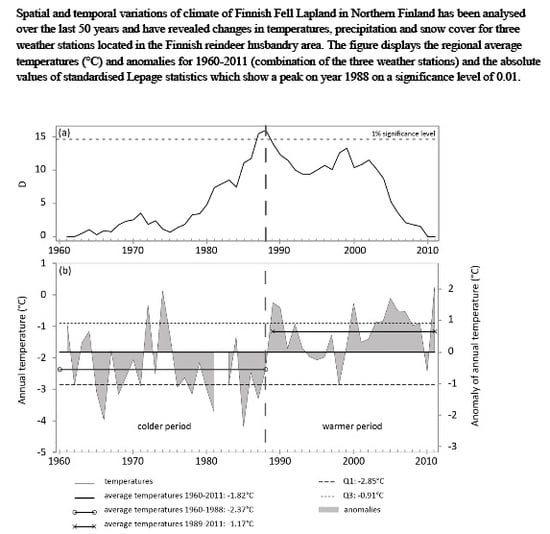Observed Regional Climate Variability during the Last 50 Years in Reindeer Herding Cooperatives of Finnish Fell Lapland
Abstract
:1. Introduction
2. Materials and Methods
2.1. Analysing the Regional Homogeneity
2.2. Analysing the Interannual and Seasonal Variability
2.3. Analysing the Cold Intensity
3. Results
3.1. Regional Climate Homogeneity
3.2. Regional Climate Variability
3.2.1. Annual Temperature Variability
3.2.2. Seasonal Temperature Variability
3.3. Local Climate Variability
3.3.1. Interannual Variability of Precipitation and Snow Cover
3.3.2. Seasonality of Interannual Variability in Precipitation
- In the winter, the amplitude of the anomalies, especially positive ones, has increased with the time for all cases, even though it is more visible for Kilpisjärvi. For the three sites, two distinct periods are discernible: the first one from the 1960s to the end of the 1980s (a bit earlier for Enontekiö, mid-1980s), annual anomalies were mostly negative meaning less precipitation; and the second one from the late 1980s onwards, annual anomalies have been positive at the exception of the late 2000s. This increase in average amount of precipitation needs to be interpreted in concordance with temperature trends meaning that the share of rainy precipitation has probably grown at the expense of snowfall.
- In general, the variability of spring precipitation is quite low with the exception of the last decade in Kilpisjärvi. However, for the three sites, the first positive anomalies have been recorded in the 1970s and, since then, they have been much more frequent than the negative ones, meaning that springs get slightly wetter.
- The summer is the most variable season in terms of precipitation, and this is the case in the three case studies. The similarity of the variability of the three stations was already shown in Table 2. No specific trends can be noticed.
- Since the 1960s, the autumn season has recorded a quite low annual variability of precipitation for the three weather stations without any specific trend.
3.4. Cold Intensity
3.4.1. Degree-Days
3.4.2. Frost and Thaw Cycles
- at Kilpisjärvi weather station, the average of cycles is approx. 11 per year. Among the three stations, it is the one that normally records the most of cycles every year, up to 19 in 2003. Since the 1990s, a slight increase of those cycles has occurred.
- at Enontekiö, whose average is about nine cycles per year, the increase is very clear even though the station does not record as many frost and thaw cycles as the two other stations.
- at Muonio, the number of cycles flows around the average of 10 per year without any discernible trend even for recent years.
4. Discussion
- It is difficult to speak about full climate regional homogeneity when only mean temperatures have revealed quite good correlation coefficients (r > 0.97), unlike precipitation and snow cover. Nevertheless, for all cases, annual and seasonal, Enontekiö and Muonio weather stations are the closest ones.
- For the annual temperature data, a warming trend is discernible for the period 1960–2011 with two distinct periods: a colder period between 1960 and 1988 with greater negative anomalies and strong cold intensity (lowest negative peaks of degree-days recorded before 1990); and a warmer period from 1989 to 2011 with greater positive anomalies and +1.20 °C of average temperatures compared to the previous period. It can also be seen that this most recent period has recorded slightly more frost and thaw cycles whose high occurrence is strongly linked to the warming of the climate at the high latitudes. As for seasonal data, variations in mean temperatures have been found to be more important during wintertime, partly due to the strong correlation with the AO index.
- Muonio is the weather station that has recorded the largest amount of precipitation. The annual data of precipitation have shown that a drier period occurred before 1988 for Kilpisjärvi and Muonio. Most of the positive anomalies have been recorded after 1988, meaning that the general trend is about receiving more precipitation. Nevertheless, no clear trend has appeared for Enontekiö. Concerning the seasonal variability of precipitation, the results have shown that summer is the season with the highest amplitude and number of variations for the three cases. As for the autumn, no specific trend is discernible. Winter and spring precipitation, however, has evolved differently, and Kilpisjärvi has stood out from the other weather stations. For both seasons, Kilpisjärvi has recorded larger amplitude of positive anomalies compared to Enontekiö and Muonio despite the quite low variability of precipitation. For both seasons and for the three sites, precipitation is increasing with time with more and more rainy winter precipitation, especially from the beginning of the 1990s. A slight decrease has been recorded from the beginning of the 2000s.
- None of the sites shows a discernible trend in the snow cover.
Acknowledgments
Author Contributions
Conflicts of Interest
References
- ACIA. Arctic Climate Impact Assessment Scientific Report; Cambridge University Press: Cambridge, UK, 2005. [Google Scholar]
- Barber, D.; Lukovich, J.V.; Keogak, J.; Baryluk, S.; Fortier, L.; Henry, G.H.R. The changing climate of the Arctic. Arctic 2008, 61, 7–26. [Google Scholar] [CrossRef]
- Larsen, J.N.; Anisimov, A.; Constable, A.; Hollowed, A.B.; Maynard, N.; Prestrud, P.; Prowse, T.D.; Stone, J.M.R. Polar regions. In Climate Change 2014: Impacts, Adaptation, and Vulnerability. Part B: Regional Aspects. Contribution of Working Group II to the Fifth Assessment Report of the Intergovernmental Panel on Climate Change; Barros, V.R., Field, C.B., Dokken, D.J., Mastrandrea, M.D., Mach, K.J., Bilir, T.E., Chatterjee, M., Ebi, K.L., Estrada, Y.O., Genova, R.C., et al., Eds.; Cambridge University Press: Cambridge, UK; New York, NY, USA, 2014; pp. 1567–1612. [Google Scholar]
- Rautio, A.; Poppel, B.; Young, K. Human health and well-being. In Arctic Human Development Report. Regional Processes and Global Linkages; Nymand, L., Fondahl, G., Eds.; Nordic Council of Ministers: Copenhagen, Denmark, 2015; pp. 297–346. [Google Scholar]
- Adger, W.N. Vulnerability. Glob. Environ. Chang. 2006, 16, 268–281. [Google Scholar] [CrossRef]
- Folke, C. Resilience: The emergence of a perspective for social-ecological systems analyses. Glob. Environ. Chang. 2006, 16, 253–267. [Google Scholar] [CrossRef]
- Callaghan, T.V.; Bergholm, F.; Christensen, T.R.; Jonasson, C.; Kokfelt, U.; Johansson, M. A new climate era in the sub-Arctic: Accelerating climate changes and multiple impacts. Geophys. Res. Lett. 2010, 37, L14705. [Google Scholar] [CrossRef]
- Stocker, T.F.; Qin, D.; Plattner, G.K.; Tignor, M.; Allen, S.K.; Boschung, J.; Nauels, A.; Xia, Y.; Bex, V.; Midgley, P.M. (Eds.) IPCC Climate Change 2013: The Physical Science Basis. Contribution of Working Group I to the Fifth Assessment Report of the Intergovernmental Panel on Climate Change; Cambridge University Press: Cambridge, UK; New York, NY, USA, 2013. [Google Scholar]
- Lee, S.E.; Press, M.C.; Lee, J.A. Observed climate variations during the last 100 years in Lapland, Northern Finland. Int. J. Climatol. 2000, 20, 329–346. [Google Scholar] [CrossRef]
- Pike, G.; Pepin, N.C.; Schaefer, M. High latitude local scale temperature complexity: The example of Kevo Valley, Finnish Lapland. Int. J. Climatol. 2013, 33, 2050–2067. [Google Scholar] [CrossRef] [Green Version]
- Irannezhad, M.; Marttila, H.; Kløve, B. Long-term variations and trends in precipitation in Finland. Int. J. Climatol. 2014, 34, 3139–3153. [Google Scholar] [CrossRef]
- Irannezhad, M.; Chen, D.; Kløve, B. Interannual variations and trends in surface air temperature in Finland in relation to atmospheric circulation patterns, 1961–2011. Int. J. Climatol. 2014, 35, 3078–3092. [Google Scholar] [CrossRef]
- Heikkinen, H.I.; Kasanen, M.; Lépy, É. Resilience, vulnerability and adaptation in reindeer herding communities in the Finnish-Swedish border area. Nordia Geogr. Publ. 2013, 41, 107–122. [Google Scholar]
- Lépy, É. Perceptions des éleveurs de rennes de Laponie finlandaise. Communications 2017, 2, 47–61. [Google Scholar]
- Turunen, M.T.; Rasmus, S.; Bavay, M.; Ruosteenoja, K.; Heiskanen, J. Coping with difficult weather and snow conditions: Reindeer herders’ views on climate change impacts and coping strategies. Clim. Risk Manag. 2016, 11, 15–36. [Google Scholar] [CrossRef]
- Rasmus, S.; Kumpula, J.; Jylhä, K. Suomen poronhoitoalueen muuttuvat talviset sää- ja lumiolosuhteet. Terra 126 2014, 4, 69–185. [Google Scholar]
- Riseth, J.A.; Tømmervik, H.; Bjerke, J.W. 175 years of adaptation: North Scandinavian Sámi reindeer herding between government policies and winter climate variability (1835–2010). J. For. Econ. 2016, 24, 186–204. [Google Scholar] [CrossRef]
- Jylhä, K.; Ruosteenoja, K.; Räisänen, J.; Venäläinen, A.; Tuomenvirta, H.; Ruokolainen, L.; Saku, S.; Seitola, T. The Changing Climate in Finland: Estimates for Adaptation Studies. ACCLIM Project Report 2009; Finnish Meteorological Institute: Helsinki, Finland, 2009. [Google Scholar]
- Lépy, É.; Heikkinen, H.; Komu, T.; Sarkki, S. Participatory meaning-making of environmental and cultural changes in reindeer herding in the northernmost border area of Sweden and Finland. Int. J. Bus. Glob. 2017, in press. [Google Scholar]
- Jernsletten, J.L.; Klokov, K. Sustainable Reindeer Husbandry; Centre for Saami Studies: Tromsø, Norway, 2002. [Google Scholar]
- Forbes, B.; Bölter, M.; Müller-Wille, L.; Hukkinen, J.; Müller, F.; Gunslay, N.; Konstatinov, Y. (Eds.) Reindeer Management in Northernmost Europe; Ecological Studies 184; Springer: Berlin, Germany, 2006. [Google Scholar]
- Helle, T.; Kojola, I. Demographics in an alpine reindeer herd: Effects of density and winter weather. Ecography 2008, 31, 221–230. [Google Scholar] [CrossRef]
- Riseth, J.A.; Tømmervik, H.; Helander-Renvall, E.; Labba, N.; Johansson, C.; Malnes, E.; Bjerke, J.W.; Jonsson, C.; Pohjola, V.; Sarri, L.E.; et al. Sámi traditional ecological knowledge as a guide to science: Snow, ice and reindeer pasture facing climate change. Polar Rec. 2011, 47, 202–217. [Google Scholar] [CrossRef]
- Vajda, A.; Venäläinen, A. The influence of natural conditions on the spatial variation of climate in Lapland, Northern Finland. Int. J. Climatol. 2003, 23, 1011–1022. [Google Scholar] [CrossRef]
- Kitti, H.; Gunslay, N.; Forbes, B.C. Defining the quality of reindeer pastures: The perspectives of Sámi reindeer herders. In Reindeer Management in Northernmost Europe; Ecological Studies 184; Forbes, B.C., Bölter, M., Müller-Wille, L., Hukkinen, J., Müller, F., Gunslay, N., Konstatinov, Y., Eds.; Springer: Berlin, Germany, 2006; pp. 141–165. [Google Scholar]
- Côté, S.; Festa-Bianchet, M.; Dussault, C.; Tremblay, J.P.; Brodeur, V.; Simard, M.; Taillon, J.; Hins, C.; Le Corre, M.; Sharma, S. Caribou herd dynamics: Impacts of climate change on traditional and sport harvesting. In Nunavik and Nunatsiavut: From Science to Policy. An Integrated Regional Impact Study (IRIS) of Climate Change and Modernization; Allard, M., Lemay, M., Eds.; ArcticNet Inc.: Quebec City, QC, Canada, 2012; pp. 249–269. [Google Scholar]
- Turunen, M.; Soppela, P.; Kinnunen, H.; Sutinen, M.L.; Martz, F. Does climate change influence the availability and quality of reindeer forage plants? Polar Biol. 2009, 32, 813–832. [Google Scholar] [CrossRef]
- Bartsch, A.; Kumpula, T.; Forbes, B.; Stammler, F. Detection of snow surface thawing and refreezing in the Eurasian Arctic with QuikSCAT: Implications for reindeer herding. Ecol. Appl. 2010, 20, 2346–2358. [Google Scholar] [CrossRef] [PubMed]
- Hansen, B.B.; Aanes, R.; Herfindal, I.; Kohler, J.; Sæther, B.E. Climate, icing, and wild arctic reindeer: Past relationships and future prospects. Ecology 2011, 92, 1917–1923. [Google Scholar] [CrossRef] [PubMed]
- Lepage, Y. A combination of Wilcoxon’s and Ansari-Bradley’s statistics. Biometrika 1971, 58, 213–217. [Google Scholar] [CrossRef]
- Ross, G.J. Parametric and nonparametric sequential change detection in R: The cpm package. J. Stat. Softw. 2015, 66, 1–20. [Google Scholar]
- R Core Team. R: A Language and Environment for Statistical Computing; R Foundation for Statistical Computing: Vienna, Austria, 2014. [Google Scholar]
- Rogers, J.C. The association between the North Atlantic Oscillation and the South Oscillation in the Northern Hemisphere. Mon. Weather Rev. 1984, 112, 1999–2015. [Google Scholar] [CrossRef]
- Hurrell, J.W. Decadal trends in the North Atlantic Oscillation: Regional temperatures and precipitation. Science 1995, 269, 676–679. [Google Scholar] [CrossRef] [PubMed]
- Cohen, J.; Barlow, M. The NAO, the AO, and global warming: How closely related? J. Clim. 2005, 18, 4498–4513. [Google Scholar] [CrossRef]
- Thompson, D.W.J.; Wallace, J.M. The Arctic Oscillation signature in the wintertime geopotential height and temperature fields. Geophys. Res. Lett. 1998, 25, 1297–1300. [Google Scholar] [CrossRef]
- NOAA. Available online: http://www.cpc.ncep.noaa.gov/products/precip/CWlink/pna/nao.shtml (accessed on 30 June 2017).
- Jaagus, J. Trends in sea ice conditions in the Baltic Sea near the Estonian coast during the period 1949/1950–2003/2004 and their relationships to large-scale atmospheric circulation. Boreal Environ. Res. 2006, 11, 169–183. [Google Scholar]
- Chen, D.; Hellström, C. The influence of the North Atlantic Oscillation on the regional temperature variability in Sweden: Spatial and temporal variations. Tellus 1999, 51A, 505–516. [Google Scholar] [CrossRef]
- Lépy, É. Les Glaces de mer en mer Baltique. Étude Géographique et Implications Environnementales et Sociétales à Partir de l’étude Comparée de la Baie de Botnie (Oulu, Finlande) et du Golfe de Riga (Lettonie). Doctor’s Thesis, University of Caen-Basse-Normandie, Caen, France, 2009. [Google Scholar]
- Hurrell, J.W.; Deser, C. Northern hemisphere climate variability during winter: Looking back on the work of Felix Exner. Meteorol. Z. 2015, 24, 113–118. [Google Scholar] [CrossRef]
- Gastineau, G.; Frankignoul, C. Influence of the North Atlantic SST variability on the atmospheric circulation during the twentieth century. J. Clim. 2015, 28, 1396–1416. [Google Scholar] [CrossRef]
- Stramska, M.; Bialogrodzka, J. Spatial and temporal variability of sea surface temperature in the Baltic Sea based on 32-years (1982–2013) of satellite data. Oceanologia 2015, 57, 223–235. [Google Scholar] [CrossRef]
- Buchan, J.; Hirschi, J.J-M.; Blaker, A.T.; Sinha, B. North Atlantic SST anomalies and the cold North European weather events of winter 2009/10 and December 2010. Mon. Weather Rev. 2014, 142, 922–932. [Google Scholar] [CrossRef]
- Kivinen, S.; Rasmus, S.; Jylhä, K.; Laapas, M. Long-term climate trends and extreme events in Northern Fennoscandia (1914–2013). Climate 2017, 5, 16. [Google Scholar] [CrossRef]
- Beniston, M.; Stephenson, D.B.; Christensen, O.B.; Ferro, C.A.; Frei, C.; Goyette, S.; Halsnaes, K.; Holt, T.; Jylhä, K.; Koffi, B.; et al. Future extreme events in European climate: An exploration of regional climate model projections. Clim. Chang. 2007, 81, 71–95. [Google Scholar] [CrossRef]
- Vikhamar-Schuler, D.; Isaksen, K.; Haugen, J.E.; Tømmervik, H.; Lucks, B.; Schuler, T.V.; Bjerke, J.W. Changes in winter warming events in the Nordic Arctic Region. J. Clim. 2016, 29, 6223–6244. [Google Scholar] [CrossRef]
- Lehtonen, I.; Ruosteenoja, K.; Jylhä, K. Projected changes in European extreme precipitation indices on the basis of global and regional climate model ensembles. Int. J. Climatol. 2014, 34, 1208–1222. [Google Scholar] [CrossRef]
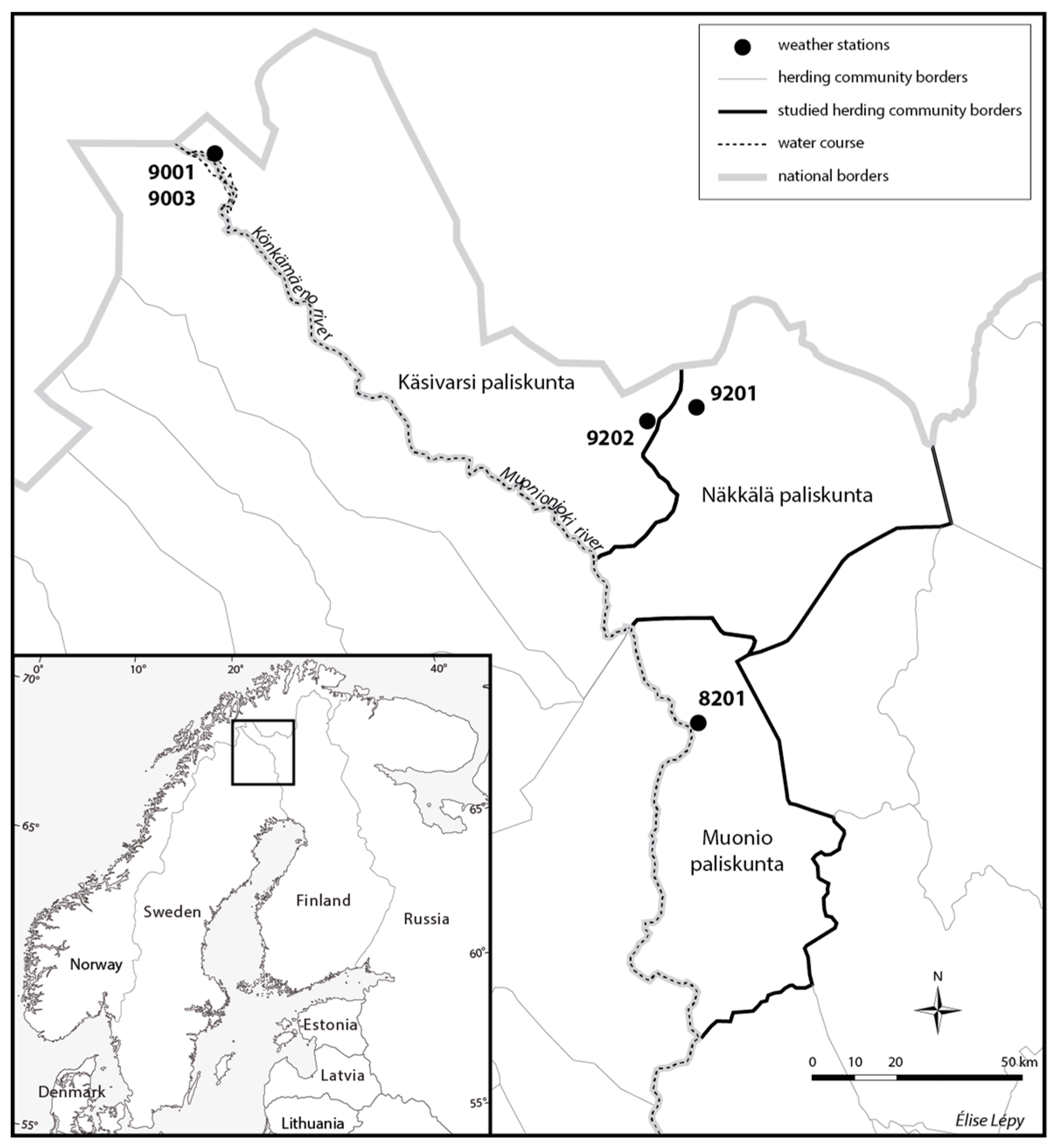
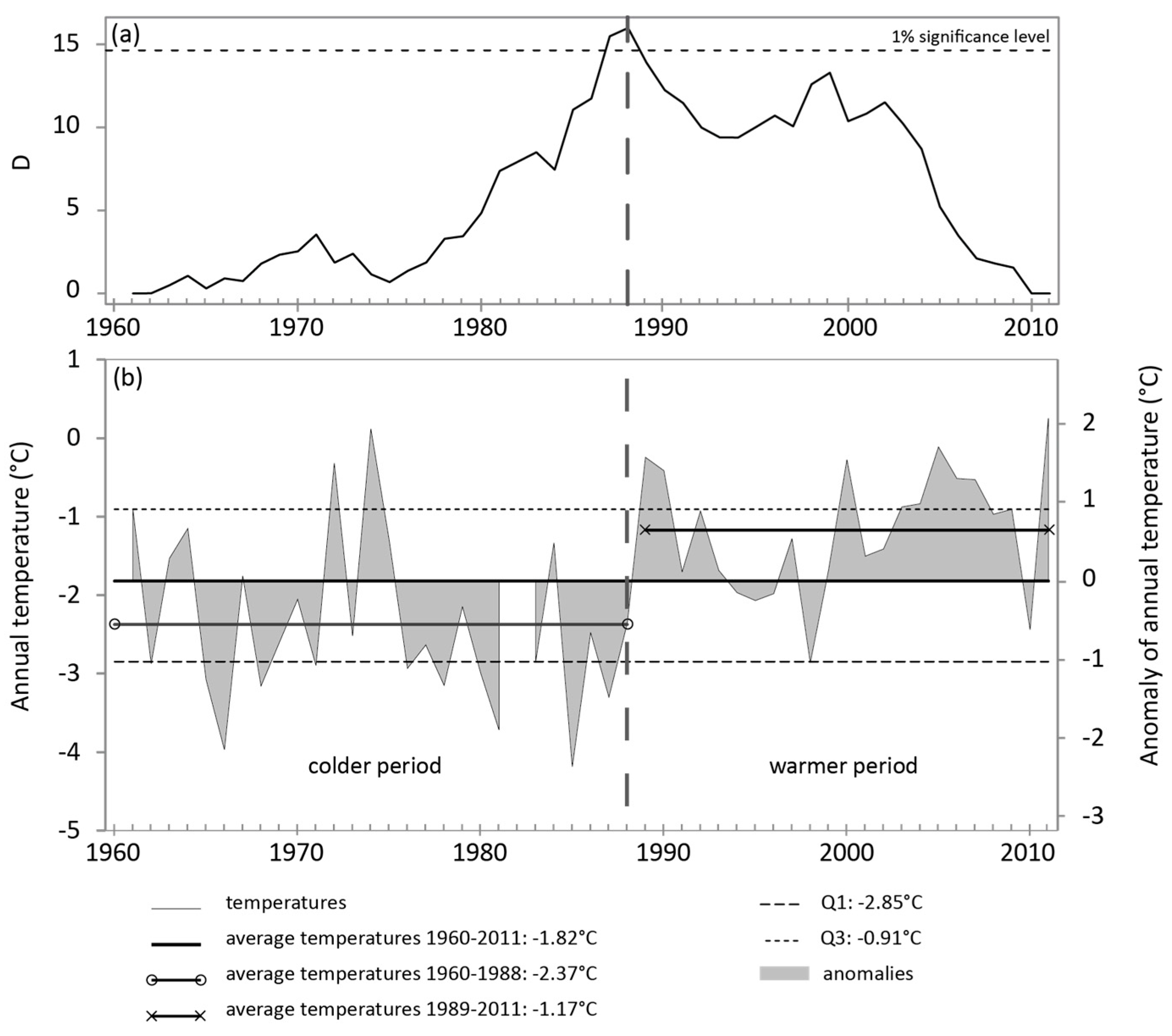
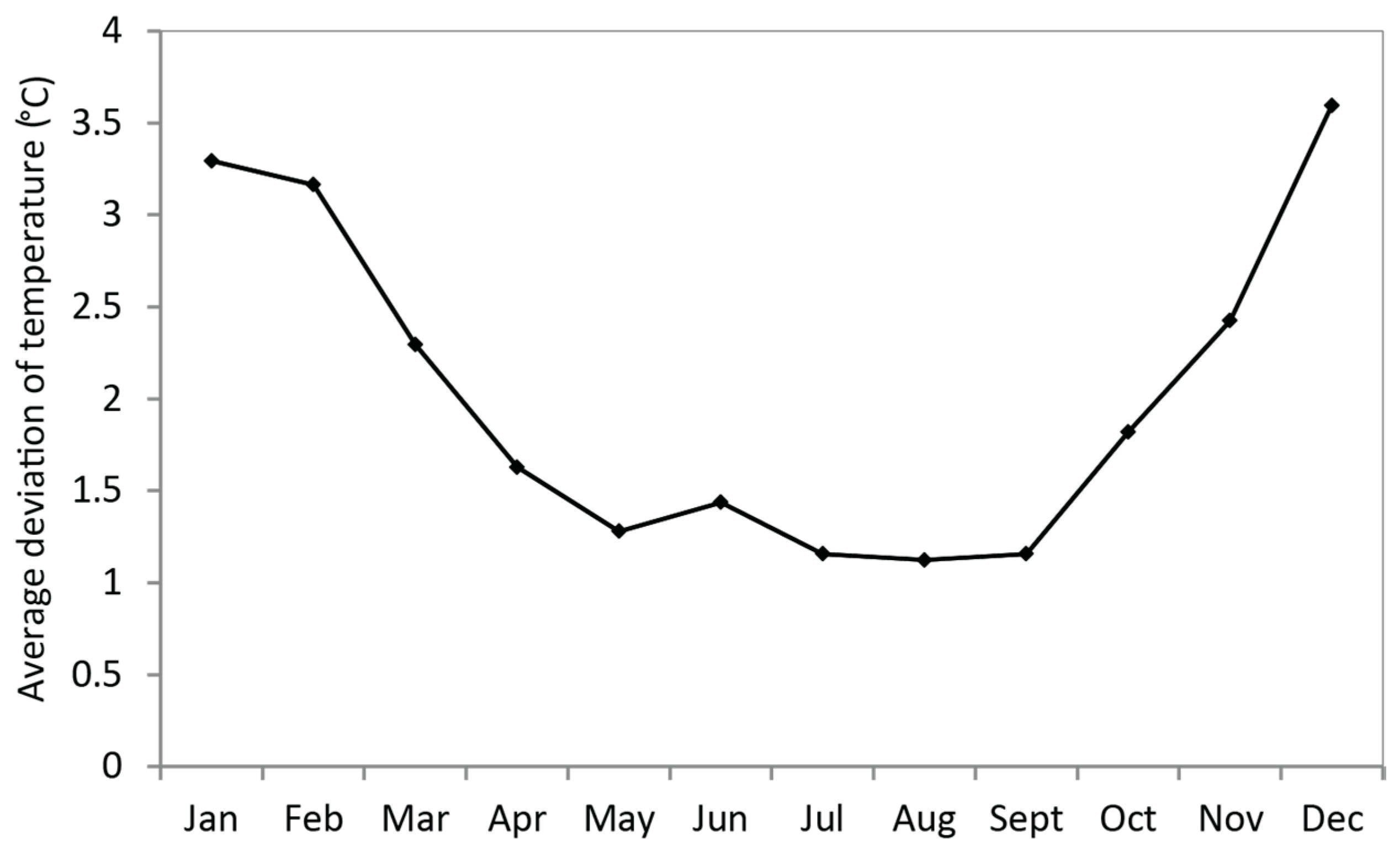
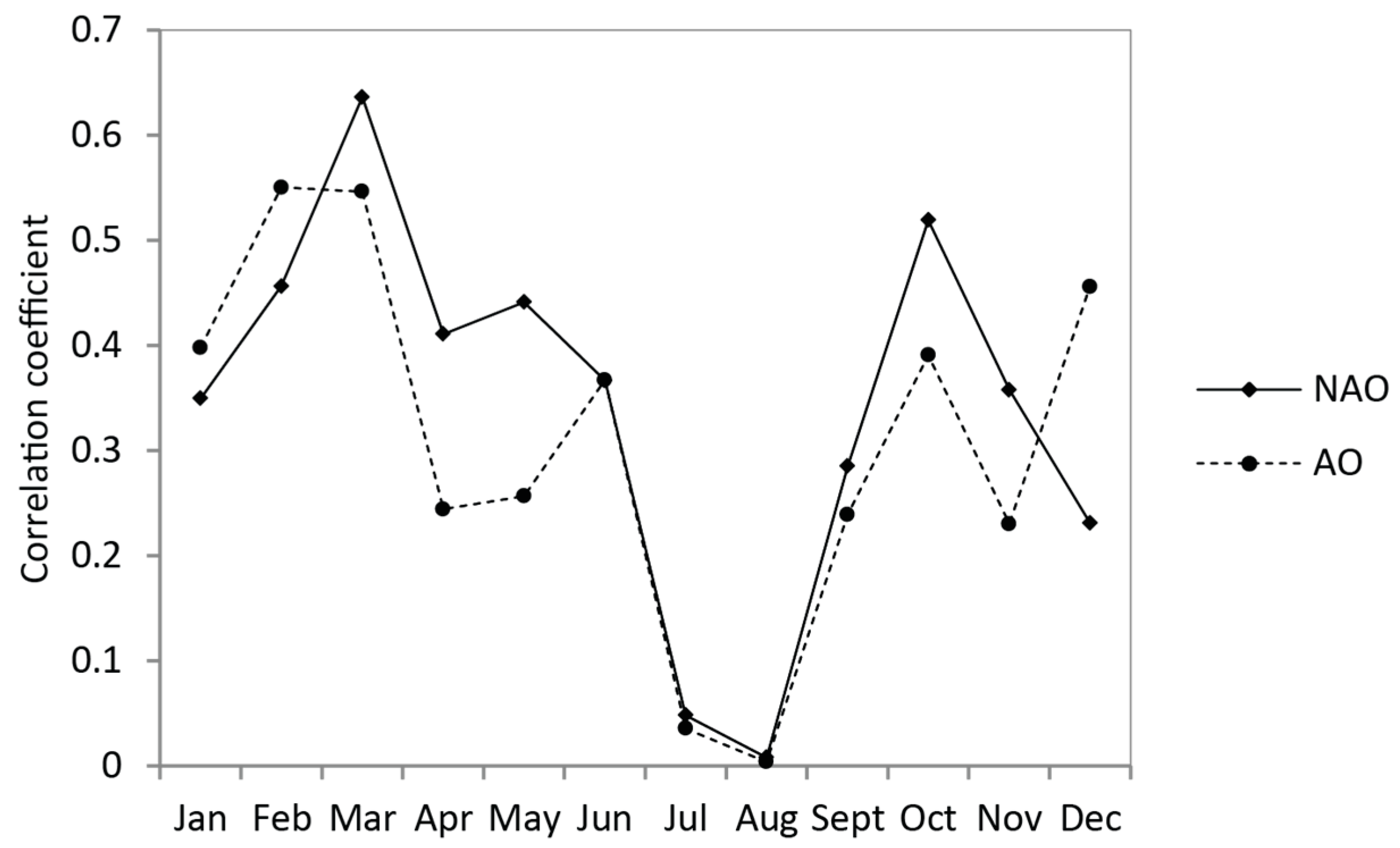
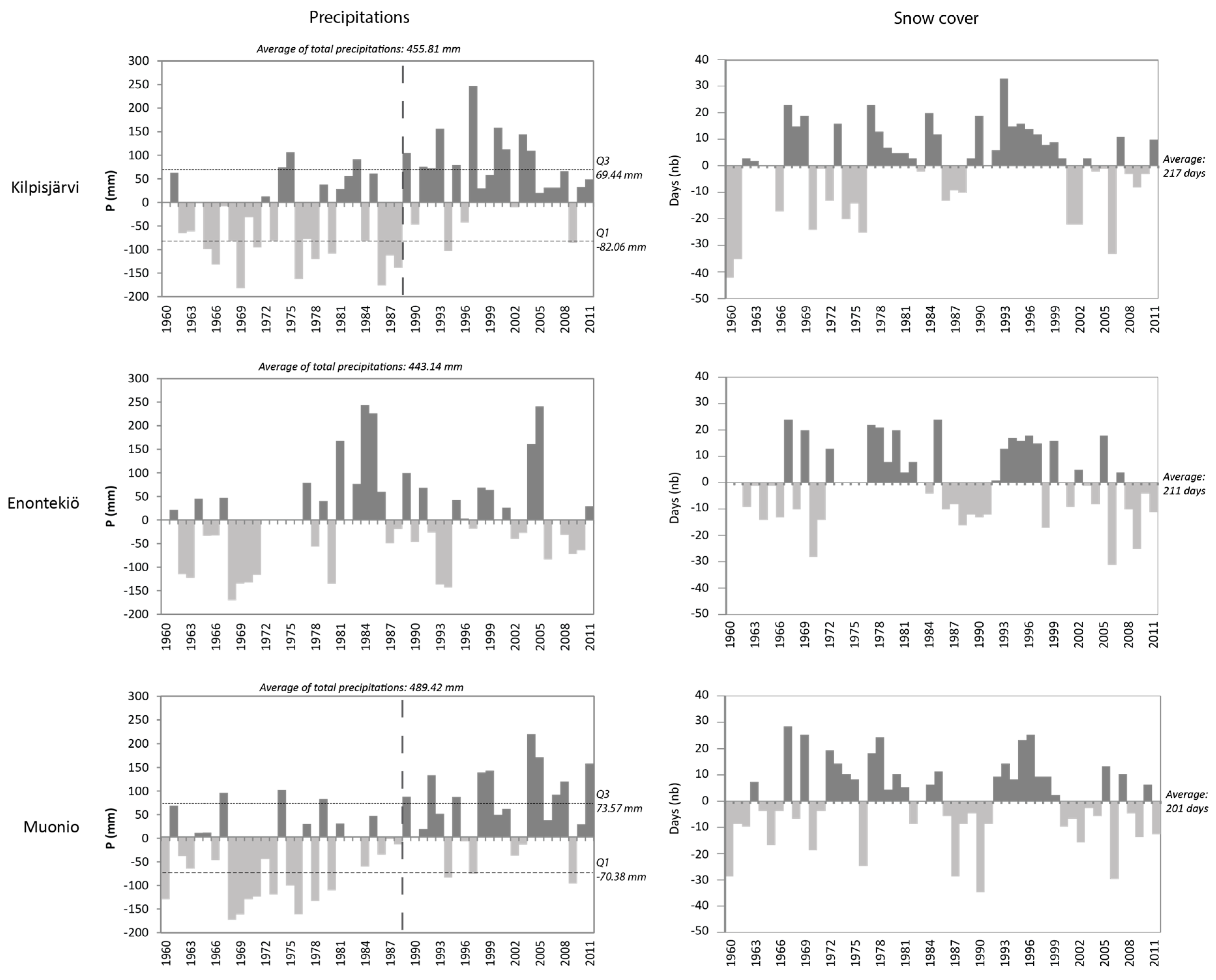
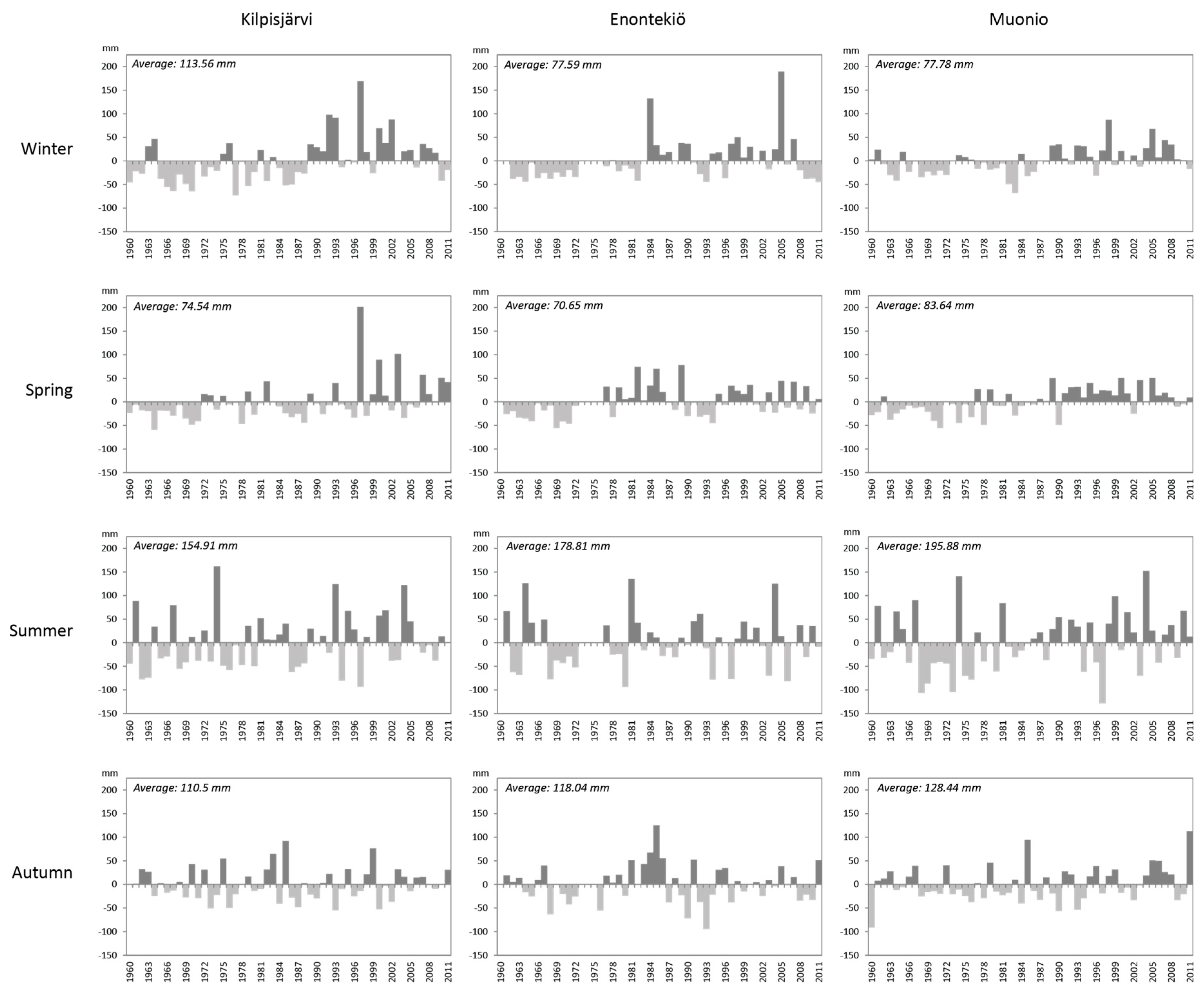
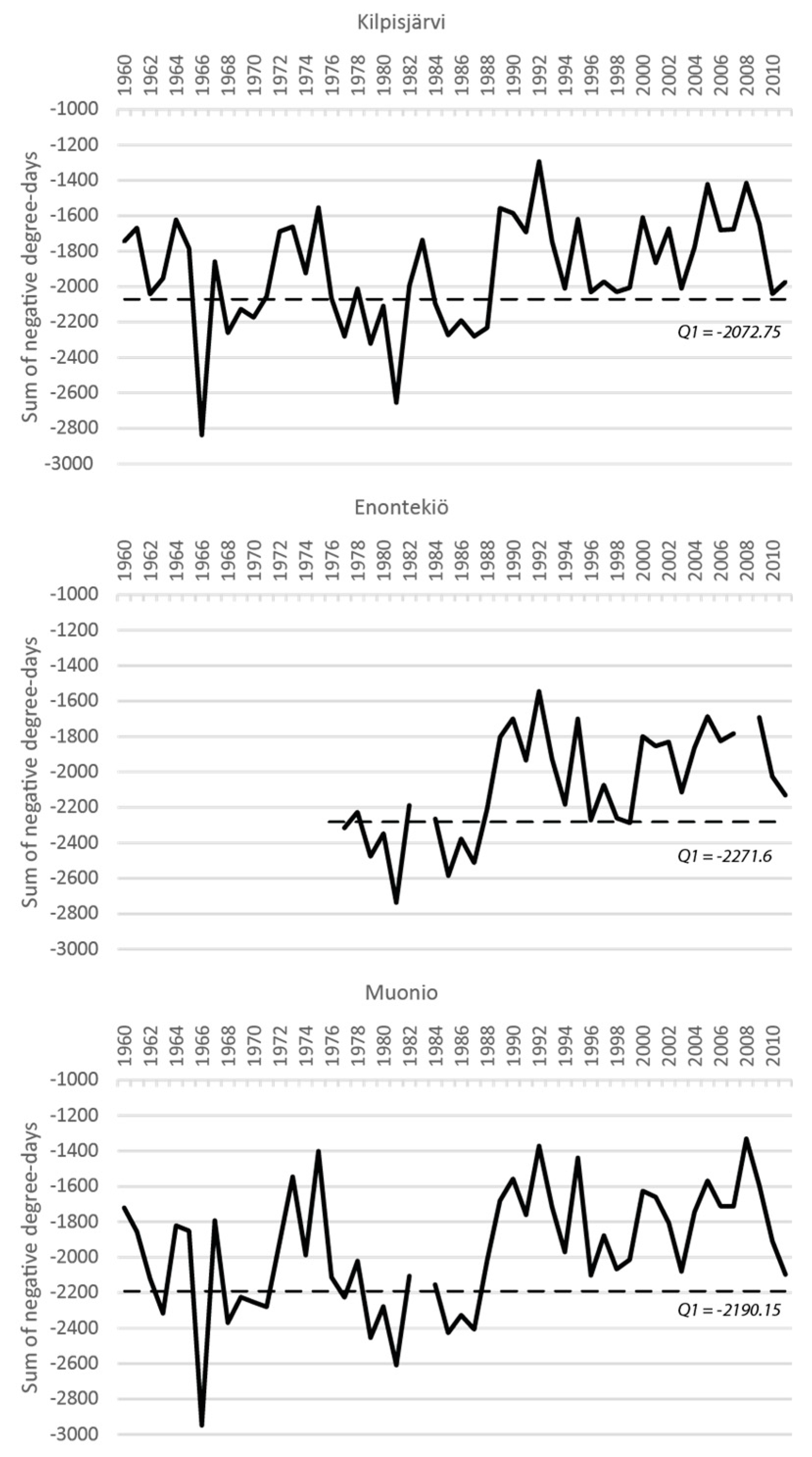

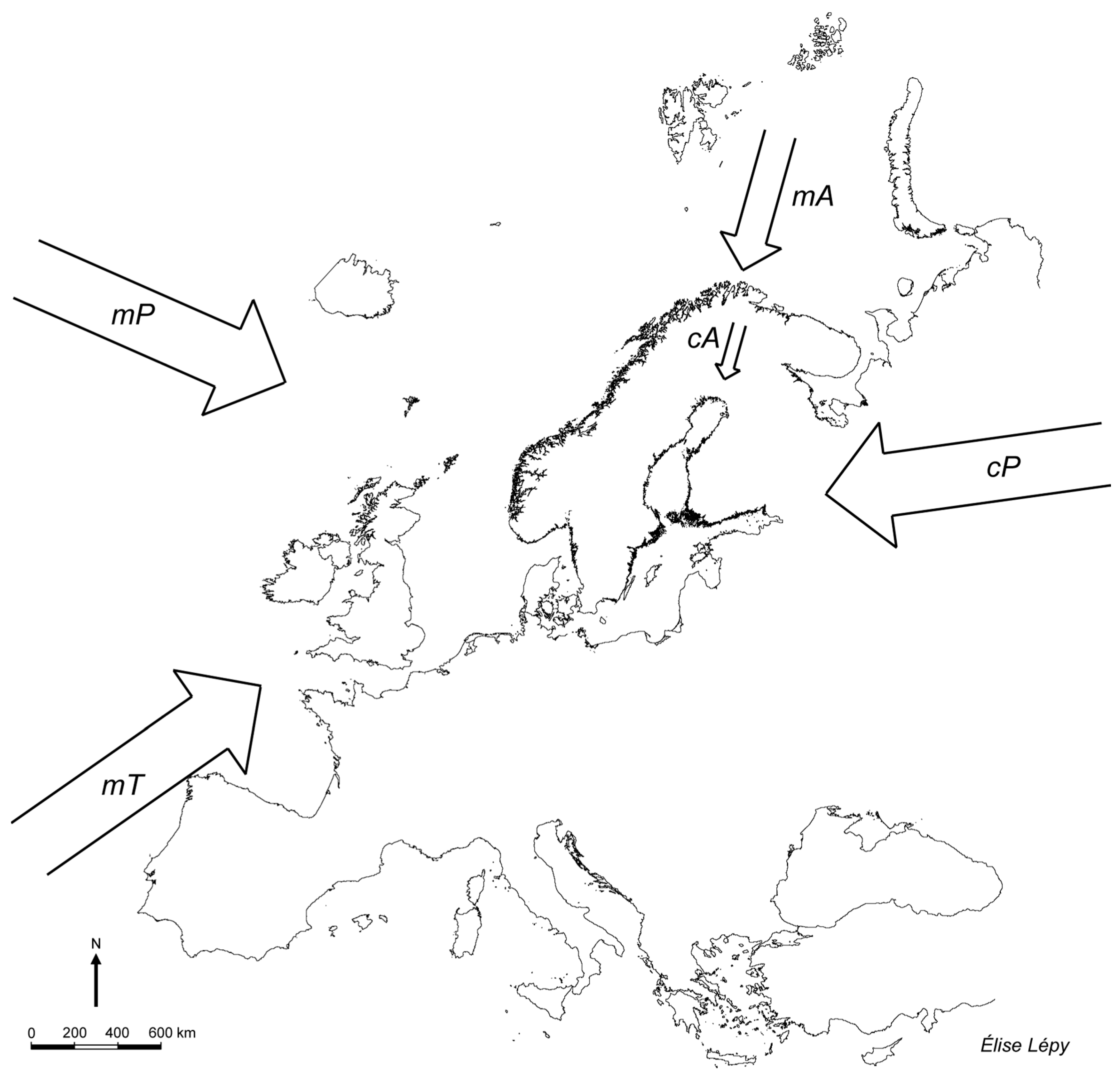
| Weather Stations | Station Reference Number | Coordinates | Elevation (m.a.s.l.) | Years Recorded |
|---|---|---|---|---|
| Enontekiö Kilpisjärvi | 9001 | 69°03′00″ N, 20°48′00″ E | 483 | 1951–1978 |
| Enontekiö Kilpisjärvi kyläkeskus | 9003 | 69°03′00″ N, 20°47′24″ E | 480 | |
| Enontekiö Palojärvi | 9202 | 68°34′12″ N, 23°19′48″ E | 356 | 1972–2000 |
| Enontekiö Näkkälä | 9201 | 68°36′00″ N, 23°34′48″ E | 374 | 1960–present |
| Muonio Alamuonio | 8201 | 67°57′36″ N, 23°40′48″ E | 236 | 1946–present |
| Mean Temperatures | |||||||
|---|---|---|---|---|---|---|---|
| Winter | K 1 | E 2 | M 3 | Summer | K | E | M |
| K | 1 | 1 | |||||
| E | 0.959 | 1 | 0.929 | 1 | |||
| M | 0.943 | 0.989 | 1 | 0.932 | 0.984 | 1 | |
| Spring | Autumn | ||||||
| K | 1 | 1 | |||||
| E | 0.943 | 1 | 0.957 | 1 | |||
| M | 0.947 | 0.988 | 1 | 0.901 | 0.976 | 1 | |
| Annual | |||||||
| K | 1 | ||||||
| E | 0.977 | 1 | |||||
| M | 0.967 | 0.982 | 1 | ||||
| Precipitation | |||||||
| Winter | K | E | M | Summer | K | E | M |
| K | 1 | 1 | |||||
| E | 0.206 | 1 | 0.629 | 1 | |||
| M | 0.383 | 0.639 | 1 | 0.717 | 0.827 | 1 | |
| Spring | Autumn | ||||||
| K | 1 | 1 | |||||
| E | 0.413 | 1 | 0.402 | 1 | |||
| M | 0.486 | 0.583 | 1 | 0.570 | 0.604 | 1 | |
| Total | |||||||
| K | 1 | ||||||
| E | 0.31 | 1 | |||||
| M | 0.568 | 0.6 | 1 | ||||
| Snow | |||||||
| Permanent snow cover >1 | K | E | M | Maximal snow depth | K | E | M |
| K | 1 | K | 1 | ||||
| E | 0.6 | 1 | E | −0.053 | 1 | ||
| M | 0.581 | 0.77 | 1 | M | 0.296 | 0.631 | 1 |
© 2017 by the authors. Licensee MDPI, Basel, Switzerland. This article is an open access article distributed under the terms and conditions of the Creative Commons Attribution (CC BY) license (http://creativecommons.org/licenses/by/4.0/).
Share and Cite
Lépy, É.; Pasanen, L. Observed Regional Climate Variability during the Last 50 Years in Reindeer Herding Cooperatives of Finnish Fell Lapland. Climate 2017, 5, 81. https://doi.org/10.3390/cli5040081
Lépy É, Pasanen L. Observed Regional Climate Variability during the Last 50 Years in Reindeer Herding Cooperatives of Finnish Fell Lapland. Climate. 2017; 5(4):81. https://doi.org/10.3390/cli5040081
Chicago/Turabian StyleLépy, Élise, and Leena Pasanen. 2017. "Observed Regional Climate Variability during the Last 50 Years in Reindeer Herding Cooperatives of Finnish Fell Lapland" Climate 5, no. 4: 81. https://doi.org/10.3390/cli5040081




